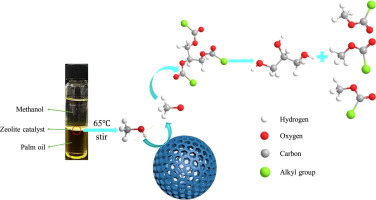Our official English website, www.x-mol.net, welcomes your
feedback! (Note: you will need to create a separate account there.)
Biodiesel production from palm oil and methanol via zeolite derived catalyst as a phase boundary catalyst: An optimization study by using response surface methodology
Fuel ( IF 6.7 ) Pub Date : 2020-07-01 , DOI: 10.1016/j.fuel.2020.117680 Pingbo Zhang , Xuan Chen , Yan Leng , Yuming Dong , Pingping Jiang , Mingming Fan
Fuel ( IF 6.7 ) Pub Date : 2020-07-01 , DOI: 10.1016/j.fuel.2020.117680 Pingbo Zhang , Xuan Chen , Yan Leng , Yuming Dong , Pingping Jiang , Mingming Fan

|
Abstract A zeolite derived catalyst was prepared by lithium modified zeolites, which can be used as a phase boundary catalyst for the reaction of soybean oil or palm oil with short chain alcohols such as methanol or ethanol. The zeolite derived catalyst was characterized by XRD, TG, SEM, CO2-TPD, DLS and contact angles (CA). The results showed that Li3AlSiO5, the main active components of the zeolite derived catalyst, had excellent catalytic activity. The surface of the zeolite derived catalyst possess the complex pore structure, and zeolite derived catalyst belonged to monodisperse system in methanol suspension. Small molecules such as methanol could diffuse easily, and fully contacted the active sites on the surface of zeolite derived catalyst, which would promote the formation of CH3O–. Interestingly, the optical contact angle indicated that the zeolite derived catalyst had a strong hydrophilicity, so that the zeolite derived catalyst was located between the two-phase boundary of the alcohol and oil. It would offer large interfacial area and overcome the mass transfer obstacles between the multi-phase, effectively enhanced the reaction rate. Furthermore, the stability test confirmed that the zeolite derived catalyst had good reusability and universality. The Response Surface Methodology (RSM) was used to optimize the process parameters of palm oil and methanol in the synthesis of biodiesel, which has better guiding significance for the industrial production of biodiesel in the future.
中文翻译:

通过沸石衍生催化剂作为相界催化剂从棕榈油和甲醇生产生物柴油:使用响应面方法的优化研究
摘要 采用锂改性沸石制备了一种沸石衍生催化剂,可作为豆油或棕榈油与甲醇或乙醇等短链醇反应的相界催化剂。沸石衍生的催化剂通过 XRD、TG、SEM、CO2-TPD、DLS 和接触角 (CA) 进行表征。结果表明,沸石衍生催化剂的主要活性成分Li3AlSiO5具有优异的催化活性。沸石衍生催化剂表面具有复杂的孔结构,沸石衍生催化剂在甲醇悬浮液中属于单分散体系。甲醇等小分子容易扩散,与沸石衍生催化剂表面的活性位点充分接触,促进CH3O-的形成。有趣的是,光学接触角表明沸石衍生催化剂具有很强的亲水性,因此沸石衍生催化剂位于醇和油的两相界面之间。它将提供大的界面面积,克服多相之间的传质障碍,有效提高反应速率。此外,稳定性试验证实该沸石衍生催化剂具有良好的重复使用性和通用性。采用响应面法(RSM)对棕榈油和甲醇合成生物柴油的工艺参数进行优化,对今后生物柴油的工业化生产具有较好的指导意义。它将提供大的界面面积,克服多相之间的传质障碍,有效提高反应速率。此外,稳定性试验证实该沸石衍生催化剂具有良好的重复使用性和通用性。采用响应面法(RSM)对棕榈油和甲醇合成生物柴油的工艺参数进行优化,对今后生物柴油的工业化生产具有较好的指导意义。它将提供大的界面面积,克服多相之间的传质障碍,有效提高反应速率。此外,稳定性试验证实该沸石衍生催化剂具有良好的重复使用性和通用性。采用响应面法(RSM)对棕榈油和甲醇合成生物柴油的工艺参数进行优化,对今后生物柴油的工业化生产具有较好的指导意义。
更新日期:2020-07-01
中文翻译:

通过沸石衍生催化剂作为相界催化剂从棕榈油和甲醇生产生物柴油:使用响应面方法的优化研究
摘要 采用锂改性沸石制备了一种沸石衍生催化剂,可作为豆油或棕榈油与甲醇或乙醇等短链醇反应的相界催化剂。沸石衍生的催化剂通过 XRD、TG、SEM、CO2-TPD、DLS 和接触角 (CA) 进行表征。结果表明,沸石衍生催化剂的主要活性成分Li3AlSiO5具有优异的催化活性。沸石衍生催化剂表面具有复杂的孔结构,沸石衍生催化剂在甲醇悬浮液中属于单分散体系。甲醇等小分子容易扩散,与沸石衍生催化剂表面的活性位点充分接触,促进CH3O-的形成。有趣的是,光学接触角表明沸石衍生催化剂具有很强的亲水性,因此沸石衍生催化剂位于醇和油的两相界面之间。它将提供大的界面面积,克服多相之间的传质障碍,有效提高反应速率。此外,稳定性试验证实该沸石衍生催化剂具有良好的重复使用性和通用性。采用响应面法(RSM)对棕榈油和甲醇合成生物柴油的工艺参数进行优化,对今后生物柴油的工业化生产具有较好的指导意义。它将提供大的界面面积,克服多相之间的传质障碍,有效提高反应速率。此外,稳定性试验证实该沸石衍生催化剂具有良好的重复使用性和通用性。采用响应面法(RSM)对棕榈油和甲醇合成生物柴油的工艺参数进行优化,对今后生物柴油的工业化生产具有较好的指导意义。它将提供大的界面面积,克服多相之间的传质障碍,有效提高反应速率。此外,稳定性试验证实该沸石衍生催化剂具有良好的重复使用性和通用性。采用响应面法(RSM)对棕榈油和甲醇合成生物柴油的工艺参数进行优化,对今后生物柴油的工业化生产具有较好的指导意义。











































 京公网安备 11010802027423号
京公网安备 11010802027423号